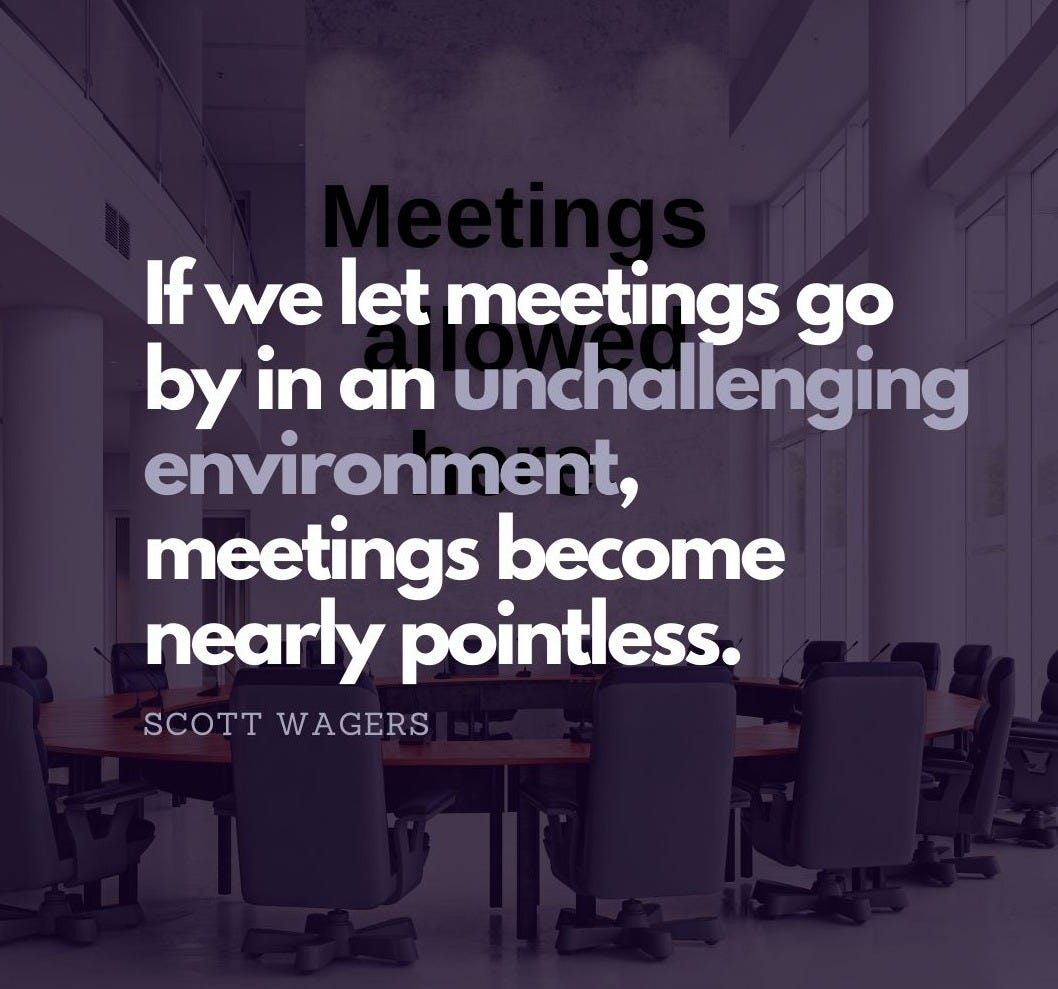From meeting monotony to magic: How tension creates collective intelligence.
These days, it is not hard to find simple advice online that you should increase your productivity by saying no to meetings.
Do we really think it makes sense to cancel all meetings?
What those simpletons don't get is that when you work with others, it's the interaction that matters.
They are right in the fact that there is a fundamental problem with most meetings.
If we fix that problem, boring, mind-numbing meetings metamorphose into inspiring, energizing ones.
What is the problem?
There is no tension.
Tension is why we watch TV or go to the movies.
Instead of enduring the monotony of Nancy monotoning her way through a glad-handing update on what is going well in her project, we would rather be on the edge of a couch waiting to see how Galadriel handles it when she finds out that the man she was almost flirting with is Sauron the evil one.
How do you add tension?
Ask a question.
Ask a simple question.
This breaks up the monotony and it gives others in the meeting time to think, or it pulls them away from their mobile phones.
It opens a space for dialogue.
Better yet, ask a stupid question.
Stupid questions are even more powerful.
They open a space for dialogue and you show your vulnerability.
An example
I was once online in a consortium meeting and a young post doc was flying through update presentation and it was his last slide.
We were about to be done in 15 minutes total. I knew there was more.
So, I asked a simple question about the basis for the choice of a particular outcome measure. This led to an extra five-minute explanation.
Good, I thought I wanted to extend the discussion and if it is just five minutes, that's great.
Then something unexpected happened.
The yellow hands started to sprout up on Teams like mushrooms after a spring rain.
The first question: Why did you choose that outcome measure?
The experienced researchers on the call had had time to think and the questions began to flow.
Tension rose.
Turns out that recruiting for the study had not been going well.
It was difficult to get study participants to agree to all the procedures.
Then a patient stakeholder spoke up.
Do you explain well enough why those procedures are important?
What had threatened to be a 15-minute meeting turned into an entire hour-long dialogue.
The meeting ended with everyone talking over each other.
We had achieved what Adam Grant describes as ‘burstiness’ (1).
There was energy and enthusiasm.
The real value of coming together is the interplay between those in the meeting.
If we let meetings go by in a unchallenging environment, meetings become nearly pointless.
No one will want to attend meetings.
Then the advice of the simple-minded online gurus to just cancel all meetings will be valid.
Why is tension so effective for meetings?
It gets attention, but more important tension challenges us to think.
Challenging a group of people to think in a meeting leads to the emergence of collective intelligence.
Collective intelligence is the intelligence of a group that is greater than the sum of the intelligence of the individual members.
Collective intelligence is more powerful than a whole boat load of siloed thinkers.
There is evidence to prove it.
In a factor analysis published in Science, researchers were able to demonstrate that there is a performance factor for a group's ability to perform a wide variety of tasks that is not explained by the sum of the IQ of the group's members or the maximal IQ.
This factor, collective intelligence, is correlated the most 38-44% with the degree of social sensitivity in the group (2).
This finding was then later confirmed in a paper in PNAS where an analysis of 22 studies in which there were more than 5,000 people in more than 1,300 groups showed a similar effect.
Collective intelligence is a real phenomenon and how you interact matters.
It is also how we are going to remain unreplaceable in face of the rise of AI.
What does this mean for meetings?
If we want to be more effective as a team, we should leverage the power of meetings.
Canceling all meetings is like deciding it is too warm in your house, so you blow up the furnace.
The wiser move would be to regulate the furnace better, turn down the thermostat.
Collective intelligence (CI) is critical to solving many scientific, business, and other problems, but groups often fail to achieve it. (3)
This is a task for everyone, but it is best to have a facilitator who is solely focused on the interaction dynamic.
The energized meeting framework
Assign a facilitator
Listen
Ask yourself if there is tension in the meeting, if not see if you can introduce some.
Ask questions to give more time for tension to rise.
or ask a provocative question
Once there is energy in a meeting, pay attention to the social interaction.
Use divergent thinking to engage everyone.
Then converge around a set of ideas with an open-ended proposal that is open to further discussion and collective thinking.
If you want to learn more about leveraging collective intelligence to enhance performance and achieve breakthrough subscribe.
References
WorkLife with Adam Grant: The Daily Show's secret to creativity | TED Talk](https://www.ted.com/talks/worklife_with_adam_grant_the_daily_show_s_secret_to_creativity/transcript
Woolley, A. W., Chabris, C. F., Pentland, A., Hashmi, N., & Malone, T. W. (2010). Evidence for a collective intelligence factor in the performance of human groups. science, 330(6004), 686-688.
Riedl, C., Kim, Y. J., Gupta, P., Malone, T. W., & Woolley, A. W. (2021). Quantifying collective intelligence in human groups. Proceedings of the National Academy of Sciences, 118(21), e2005737118.


